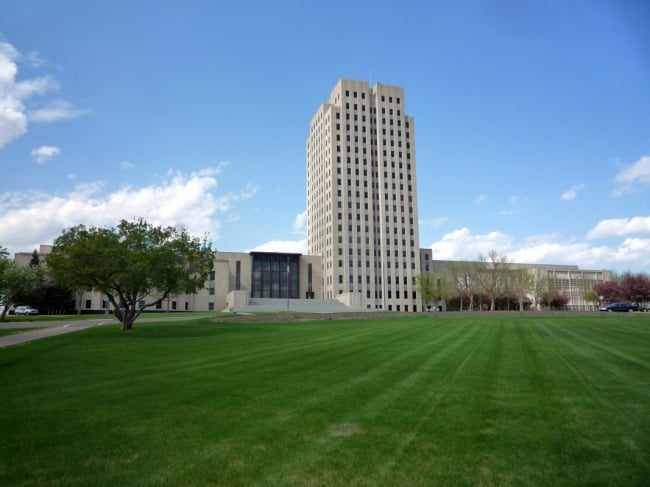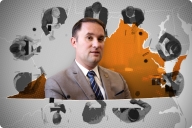You have /5 articles left.
Sign up for a free account or log in.

By Bobak Ha'Eri [CC BY 3.0 (https://creativecommons.org/licenses/by/3.0)], from Wikimedia Commons
North Dakota leaders are taking a hard look -- the second in five years -- at the constitutionally protected board governing the state’s 11 public colleges and universities, weighing possible structural changes ranging from minor tweaks to a massive overhaul.
Driven by the state’s disruption-minded Republican governor, Doug Burgum, they could recommend new boards be created to separately govern the state's research universities, four-year universities and community colleges. That would mean significant changes for North Dakota, where a State Board of Higher Education was created by constitutional amendment in the 1930s to protect members from political influence.
Burgum said a re-evaluation is necessary to make sure the state’s higher education system meets today’s needs.
“We’ve got these powerful economic forces that are being driven by rapid changes in technology,” said Burgum, an entrepreneur and former Microsoft executive who was elected governor in 2016, in an interview with Inside Higher Ed. “The digitization of every industry is occurring, and higher education in particular is not going to be immune to that. It’s also time to take a look and say, ‘Does a governance model that was built in 1939 give all the tools to our higher education system that it needs to allow them to be nimble and responsive in a time of rapid change?’”
North Dakota joins a lineup of states across the country that have re-examined their higher education governance structures of late. In some ways, discussions unfolding echo those that took place in states like Oregon and Wisconsin, where flagship universities bristling at what they saw as state-imposed constraints sought more autonomy -- or in Tennessee, where Governor Bill Haslam has championed efforts to break up or weaken statewide higher ed governance, most recently winning passage this year of a measure creating advisory boards for University of Tennessee campuses and reducing the size of the system's Board of Trustees. But advocates for centralization exist in North Dakota as well, and they can point to recent moves toward consolidation in states like Connecticut.
It remains too early to say what changes will ultimately be recommended in North Dakota, or whether a significant restructuring could realistically be put in place. Burgum kicked off the current discussion by creating a task force to examine possible changes, and some of that task force’s members seem to favor small adjustments over tearing up the existing model. Even if significant changes are recommended, any large-scale overhaul would have to go on the ballot and be approved by voters, who just four years ago rejected a measure to replace the current board structure with a three-member commission.
No matter what happens, Burgum represents a strong, unorthodox force pushing to change North Dakota’s higher education system. He has advocated for universities to be more market oriented and enterprising, speaking highly of Arizona State University’s model. And conversations with him can take unexpected turns.
The governor responded to a question about challenges facing North Dakota higher education by talking about large state industries such as energy and agriculture.
“Take carbon -- I mean, that’s in the news every day,” he said. “We have an opportunity there with our energy industry and our ag industry. Carbon’s been demonized, effectively, but it turns out plants love carbon. The whole soil health and food production is all based on the carbon cycle.”
That statement may raise eyebrows among climate scientists, who would point out that concern over carbon is based on the ways rising levels of atmospheric carbon dioxide could trap heat, drastically change global temperatures and create surface conditions that will stress animals and plants, regardless of whether they need some level of carbon to survive. Burgum went on to finish his point by saying carbon presented a research opportunity.
“Let’s figure out a way to get the carbon to the plants,” Burgum said. “You know the plants aren’t writing any editorials against carbon.”
Options on the Table
Colorful ideas aside, leaders in North Dakota are asking hard questions that apply to public universities across the country: What is the best way to build a governance structure that allows different types of colleges and universities to thrive in a quickly changing world with scarce resources? At what point is adaptability less about institutional structure and more about the people who are board members, university presidents, deans and professors?
“Is it the structure of the board that’s the problem, or is there some other problem we should solve in North Dakota?” asked Joan Heckaman, a Democratic state senator and retired teacher who is on the Task Force for Higher Education Governance. “I’m not sure our Board of Higher Education right now doesn’t have the power to do anything that we as a task force are concerned about.”
At a meeting in August, members of the higher education task force weighed a variety of options presented by a Washington, D.C.-based group, AGB Consulting. The task force narrowed the set of options to four, reported The Bismarck Tribune. The options will be considered at a meeting in late September.
The first option is keeping the current governance model of a single board over all of the state’s 11 public institutions -- its two research universities, four regional universities and five community colleges. The current board is made up of seven members appointed by the governor to four-year terms and one student appointed by the governor to a one-year term.
That first option could include minor changes like lengthening the terms of board members so they would be more politically insulated, changing the number of board members and possibly allowing the selection of board members who live out of state.
The second option still on the table is creating four boards -- one for each research university, one for the four-year universities and one for the two-year community colleges.
The third option is creating three boards -- one for each research university and one to oversee the other four-year and two-year institutions.
The final option is creating two boards -- one that would oversee the two research universities and another for the remaining four-year and two-year institutions.
Making any major changes to the governance structure would require a constitutional amendment. The task force would approve a recommendation, and the state Legislature would have to agree to put it on the ballot. Voters would then decide whether to change the Constitution. A majority of voters would have to approve of the change.
That won’t be easy, if history is any indication.
Voters have traditionally protected the State Board of Higher Education. It was formed about 80 years ago in the wake of controversy over political interference in what was then North Dakota Agricultural College, after an incident in which the college’s president and seven faculty members were fired. The year after their firings, in 1937, voters approved an amendment to the state Constitution creating the state board. North Dakota Agricultural College became North Dakota State University in 1960.
Since then, the board has changed the state’s higher education system but has itself remained largely unchanged. It created a single university system headed by a chancellor in 1990. In 1996, voters amended the state Constitution to shorten term lengths from seven years to four years.
In 2014, a lawmaker-backed ballot measure would have replaced the State Board of Higher Education with a commission made up of three paid, full-time members. The members would have been appointed by the governor to four-year terms and confirmed by the Senate.
The relationship between the board and Legislature had traditionally been tense, a state senator supporting the ballot measure, Tony Grindberg, said when the measure was on the ballot in 2014. Supporters at the time argued that the measure would make the system more efficient and modern.
“They’re not visionary leaders challenging the status quo,” Grindberg said of State Board of Higher Education members at the time. “Their environment just doesn’t foster that.”
The ballot measure proved controversial, with the Higher Learning Commission questioning how it would affect North Dakota colleges’ accreditation and the Association of Governing Boards urging residents to vote against it.
Voters rejected it three to one.
Still, controversies within the system in recent years continued to leave some politicians with a sour taste in their mouths. In 2013, then chancellor Hamid Shirvani’s management style prompted concerns. Shirvani maintained he had been brought in to enact reform, but the board ultimately bought out his contract.
More recently, the system’s current chancellor was accused by his former chief of staff of creating a hostile work environment, prompting board leaders to warn of collateral damage that could be done to innocent parties, the Grand Forks Herald reported in December.
A Challenging State
Beyond the interpersonal issues, North Dakota’s political, geographic and economic landscape presents challenges for public higher education. The state Legislature meets infrequently, only in odd numbered years. North Dakota is sparsely populated and rich in natural resources, leaving its economy and budget highly dependent on energy and agriculture. About half as many people live in North Dakota as reside in the Jacksonville, Fla., metropolitan area, yet North Dakota is about 5,000 square miles larger than the entire state of Florida.
As a result, a small number of public colleges and universities are left to serve residents in far-flung corners of North Dakota. The entire higher education system’s enrollment totaled about 44,000 this spring, across a state spanning nearly 71,000 square miles.
Work-force training remains a priority, as the North Dakota economy requires skilled craftspeople, agricultural workers and oil workers. So finding ways for different institutions to serve a variety of students has been a key point of emphasis. The North Dakota University System has invested heavily in making it easy for students to transfer credits. In some cases, two-year degree programs are offered at four-year colleges, and vice versa.
At the same time, forces push for more investment in the state’s research universities, both of which are on the eastern side of the state, far away from the oil fields to the west. Fear runs high about the prospect of losing top talent to larger, better-resourced university systems on the coasts. Pressure mounts to invest in research that could boost economic fortunes in the future.
So some members of Burgum’s Task Force for Higher Education Governance like the idea of a decentralized structure that would have board members focusing on the needs of specific institutions.
The state higher education system should be more responsive to market demand signals, said Katherine Mastel, a task force member who is a student at North Dakota State University.
“It’s hard when you have two research universities along with four-years and two-years in one basket,” said Mastel, a marketing major who last year served as the research university’s student body vice president.
Tensions have long existed between the state’s two research universities and its other nine higher education institutions, said another task force member, Mike Nathe. Nathe is a Republican state representative who formerly chaired the House’s education committee.
“There’s always been this rub between the two research universities and the other nine,” Nathe said. “We worked hard as a state to make this into one system where they have shared services and common course coding. If we go to a tiered system, that’s going to go away.”
From a lawmaker’s perspective, a lot of effort has gone into keeping state funding for universities uniform, Nathe said. Going to a tiered system could lead to unexpected changes in funding and other areas.
Nathe was leaning toward coming up with a different governance structure earlier in the task force process, he said. Now, he’s not so sure. He has reservations that will have to be discussed. Leaders within the system have also expressed concern, according to Nathe.
“I’ve had, since this came up, a couple of small-school presidents call me, and they’re not very happy,” he said. “They like the current system. They feel the system has learned from its mistakes in the last 10 years and is becoming more responsive.”
Certain governance structures could increase competition between the state’s colleges and universities, the chancellor for the North Dakota University system, Mark Hagerott, has warned. He emphasizes that a unified system of governance brings benefits like limiting redundancy in staffing.
In theory, costs go up if each tier of institution gains its own board. Coordination could become harder. Having one coordinating board can make it easier to balance different priorities while keeping the different institutions, types of institution and geographic regions from splintering along their own interests.
Hagerott still thinks it is an important moment to take stock of the system and its governance structure.
“I can clearly see the need for some improvements,” Hagerott said. “For a state our size to have to go into multiple boards, I could see some real challenges to that. But again, I respect the work of the task force, and we’ll hear what their thoughts are.”
North Dakota is far from the only state examining its governance structure. West Virginia governor Jim Justice created a blue-ribbon commission to examine higher education, a process that has been highly contentious as leaders at the state’s regional universities fear a power grab by the flagship West Virginia University. Connecticut has been struggling to find a way to consolidate its 12 community colleges into a single system. Wisconsin has also pursued merger plans.
But each state’s situation is unique, said Robert E. Anderson, president of the State Higher Education Executive Officers association. When re-examining governance structures, political and cultural histories need to be considered, he said. Sometimes structures are criticized for being too big, too unwieldy or too old and rigid. Other times they draw fire for redundancy.
Ultimately, the discussions boil down to finding a way to make the most productive use of limited resources, Anderson said.
“One thing that’s important to consider is that the buck has to stop with someone who is responsible for enacting a state strategy or plan,” Anderson said. “You have to have an individual or office that has the authority to carry that plan out.”
Anderson has served in public higher education administrative roles in Tennessee, West Virginia and Georgia. He’s grown to appreciate different governance structures in different contexts. One board at the state level can put policy changes into place very swiftly. Locally based structures require more buy-in from more people, but when parties do rally around a policy, they bring deep understanding and institutional support that can be important.
As for North Dakota, Anderson gave the state credit for a process that appears transparent.
“I think it’s important for all stakeholders to understand the process,” he said. “The fact that they’re being presented the various models to debate and discuss, I think, is a very healthy way to go about this.”








